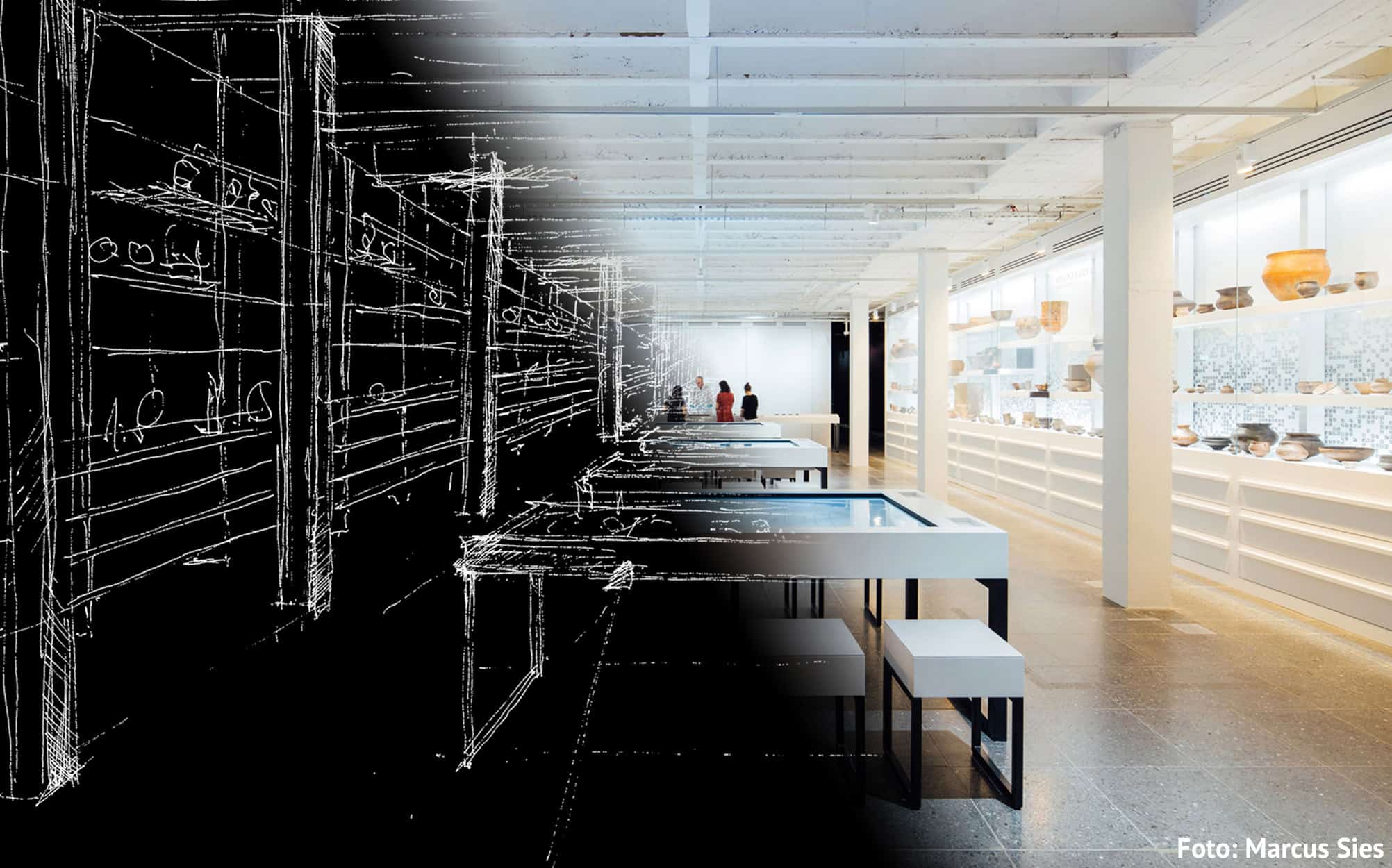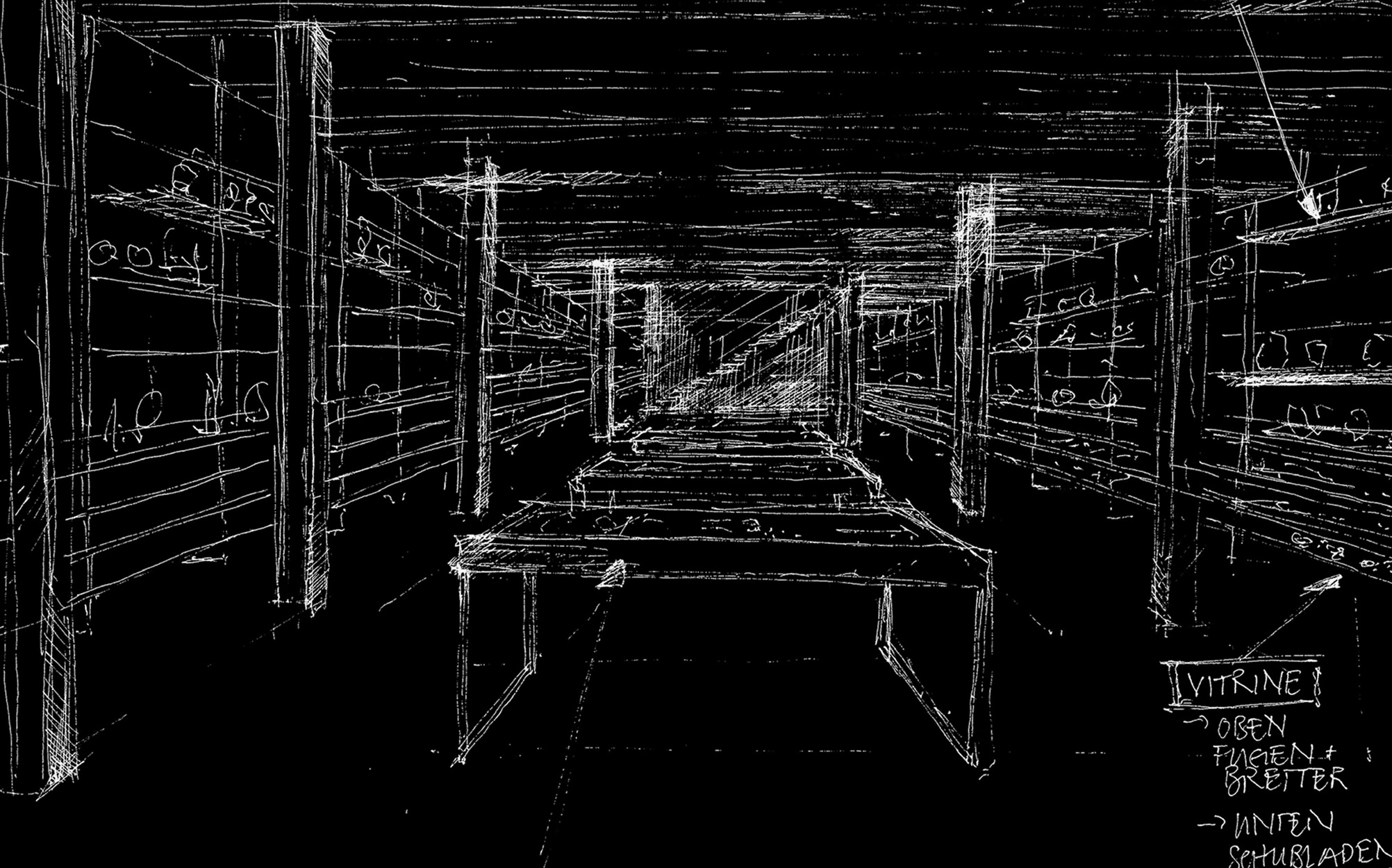Media Exhibition Design

Media Exhibition Design
In the advanced course on Media Exhibition Design, students from different disciplines and universities develop innovative, interactive exhibition concepts. What makes it special: at the end of the four-semester course cycle, a fully student-conceived and built exhibition is created, which is on display for several months in exhibition spaces in Konstanz. From impressively architecturally staged rooms to novel, interactive technology – previous exhibitions have impressed both visitors and critics. For example, the exhibition Rebuild Palmyra won both a Silver Nail in the Art Directors Club Junior Competition and the Adobe Government Creativity Award.
Interdisciplinary
Modern exhibitions require the interplay of very different disciplines. This is reflected in the course structure. In a nationwide unique collaboration of three universities, five different disciplines work together on the conception and realization of an exhibition: Architecture and Communication Design (HTWG Konstanz), History and Computer Science (University of Konstanz), as well as Music Design (Trossingen University of Music).
Each discipline contributes its own expertise. The unifying methodological framework is scenography, which can be understood as the study or art of spatial staging, with spaces that can be experienced both physically and virtually. Architects examine the spatial requirements and design novel room and furnishing concepts. Communication designers focus on the design of typefaces and graphics for analog and digital media, creating cohesive spatial impressions. Historians determine the content of these spaces by selecting exhibits and writing the texts for the rooms and objects on display. Computer scientists develop media stations seamlessly integrated into the space with intuitive interaction concepts, thereby taking responsibility for the virtual spatial layer. Music designers shape the auditory dimension of the exhibition, significantly contributing to an immersive experience for visitors. The design of these various real, virtual, visual, and acoustic spatial layers takes place in close coordination and involves numerous iterative adjustment processes. Each discipline provides its own methodological contribution, which only fully unfolds through the holistic interplay in the sense of scenography.
From concept to exhibition in four semesters
Museums and Exhibitions – History and theoretical foundations
Museums and exhibitions are of central importance for historical culture: According to the latest survey by the Institute for Museum Research for the year 2023, over 100 million visits were counted in German museums and exhibition venues, a good part of them in historically oriented institutions and shows – thus they reach a many times larger audience than the most successful historical films in the cinema.
The course is designed as an introduction to the world of museums and exhibitions. Both have their origin in the practice of collecting, important precursors are the early modern cabinets of curiosities and treasure chambers with their very own orders of knowledge and claims to representativeness. Building on this, the course pursues three lines: on the one hand the development of museums, which, after the opening of the Louvre in 1793, became enormously differentiated and have experienced a sustained boom since the 1970s; on the other hand practices of exhibiting, ranging from the World Exhibition in London in 1851, through the introduction of education in the early 20th century, to increasingly sophisticated scenographies and blockbuster formats since the 1980s; finally, it will deal with current challenges such as strengthening participation, dealing with colonial heritage, and the potentials of artificial intelligence.
Course number
HIS-42800
Media exhibition design.
Interactive media in the context of space, light, sound, and graphics
In this course, students from various disciplines have the opportunity to work together on challenging fictional projects and to develop new technical and design approaches.
The focus is on the different parameters of a media-staged exhibition. The fundamentals of scenography are taught, with expert input provided through lectures by the participating professors (historians, architects, computer scientists) as well as other specialists on topics such as staging, lighting design, sound design, graphic design, and interaction design.
In interdisciplinary working groups, experimental design approaches are developed in collaborative exercises on the following topics:
- Storytelling
- Mise en scène – contextualization of a historical object
- Dramaturgy and exhibition parcours
- Light choreography
- Sound scenography
- Typographic explanatory system
- Interactive digital object presentation
Course number history
INF-21060
HIS-40260
Course number architecture and design
112991
Course number computer science
INF-21060
INF-29340
Concept of an exhibition
In the first two semesters, students learned the fundamentals of exhibition design through professional exhibitions and fictional projects. They are now confronted with a topic that must be realized in a real exhibition.
As in the second semester, small groups are formed, each including students from every discipline. In these groups, students gradually develop contributions to the overall exhibition concept. The interim results are presented weekly to the other groups and instructors, enabling excellent supervision and continuous creative exchange among all participants.
Over the course of the semester, the small groups present their final results. Close to real professional practice, this pitch involves the instructors and other students acting as the jury or clients. The design of the winning group is ultimately realized in the fourth semester.
Although the exhibition itself is not yet completed at the end, concepts have nevertheless received awards in the past. For example, both the concept for Rebuild Palmyra and for LINK won the Seestern Student Prize from HTWG Konstanz in collaboration with the Association of German Architects. The concept for “Arriving? Migration, Faith, and Identity” has recently won the Grenzstein prize for the best transgressive project.
Course number history
HIS-41030
HIS-41680
Course number architecture and design
112991
Course number computer science
INF-14870
INF-14880
Exhibition development and implementation
The final semester is fully dedicated to the realization of the exhibition conceived in the third semester. For the students, this is a unique opportunity to gain professional experience within an academic course.
Every discipline is involved: architects prepare construction plans and material lists and hold discussions with potential suppliers. Historians write the final room, exhibit, and press texts and take care of the exhibits. Communication designers set the historians’ texts, finalize the graphics, and pass them on to partners for printing. In close collaboration with the communication designers, computer scientists program the exhibition’s interactive elements and ensure seamless integration of hardware and software at each media station. Often, interactive media stations are also built by hand. In addition to creating the sound design, the music designers must also plan how to achieve the best possible technical sound setup for the exhibition.
Throughout the semester, students and instructors meet weekly to review progress. In the final weeks before the opening, the exhibition is set up together. Every helping hand is needed, as the installation is also carried out entirely by the students themselves. It pays off: for many students, the opening night is a highlight of their academic journey.
Course number history
HIS-41960
HIS-42490
Course number architecture and design
112991
Course number computer science
INF-14080
INF-15300




